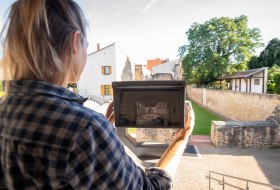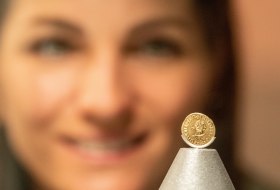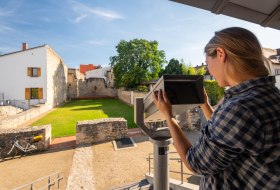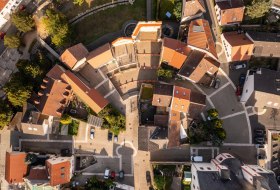searchMenu

There are various ways to discover and explore the history of the Imperial Palace in Ingelheim. Our tour guides offer interesting guided tours that bring the imperial palace and its stories to life through words. For those who want a more individual experience, we recommend the signposted circular walk through the hall area. An absolute must for every visitor is the gold coin, the so-called Solidus of Charlemagne, which is exhibited in the museum near the Imperial Palace!

The proximity to the Rhine and the expansive view of the Rhine plain may have been particularly appealing to Charlemagne when he had the magnificent imperial palace built 15 kilometres west of Mainz towards the end of the 8th century. The imperial palace served a further 17 kings and emperors as a temporary seat of government. In the archaeological zone, which today extends over an entire residential area, impressive ruins still bear witness to the splendour of the former monumental building. The foundations of the rest of the complex lie…

A large exhibition room is dedicated to Charlemagne's imperial palace, which also houses the imperial palace visitor centre with three computer terminals. The most spectacular find from the Imperial Palace in Ingelheim to date, the solidus or gold coin of Charlemagne, is also on display here. The external monuments of the imperial palace are in the immediate vicinity, as the museum is located in the entrance area of the important monument. In addition, the permanent exhibition provides information about prehistory and early history, Roman…

The Aula regia, the throne hall of the Ingelheim imperial palace, was built at the end of the 8th century and is part of the founding building under Karl the great (747 / 48−814). The throne hall was the most important public building and served as a representative meeting place. This shows also on the basis of their high-quality building equipment, the remains of which were found during archaeological excavations. Parts of the from antiquity Inspired building jewelry, including fragments of the wall paintings and the precious…

At this point, under Charlemagne (747 / 48−814), a semicircular building with a diameter of about 89 meters was built, which gave the Ingelheim Palatinate its characteristic floor plan. Its curved shape was deliberately based on the architecture of antiquity. In front of the semicircular building was a large colonnade in the direction of the inner courtyard, reminiscent of a Roman villa. The semicircular building was entered from the outside through an imposing gate, which was located at its apex. It is known today under the name…

For a long time it was believed that the hall church was Charlemagne's palatine chapel. Archaeological excavations from 1960 to 1963 showed, however, that the church was not built until after the year 900, under Ottonian rule. However, the latest charcoal samples from the foundation date the church to the years 1027-1154, i.e. the time of the Salians. In 2004 archaeologists found two early medieval predecessor buildings to the north of the hall church during excavations. They probably served Charlemagne and the following rulers as a small…
Tourist-Information im Winzerkeller
Binger Straße 16
55218 Ingelheim am Rhein
Tel: (0049) 6132 710 009 200Tourist-Information im Winzerkeller
Binger Straße 16
55218 Ingelheim am Rhein
Tel: (0049) 6132 710 009 200